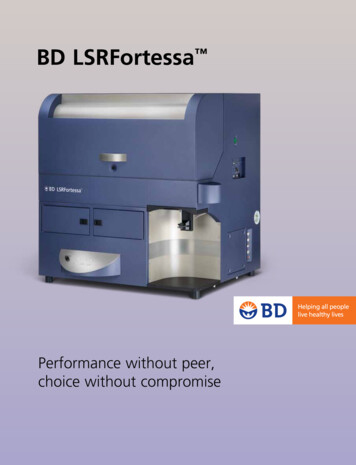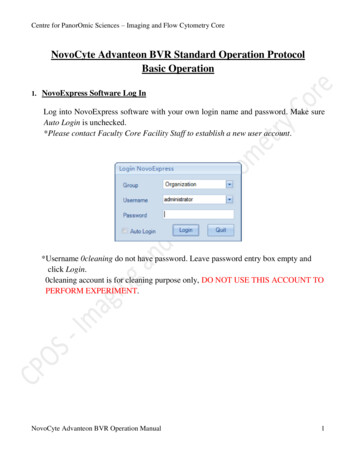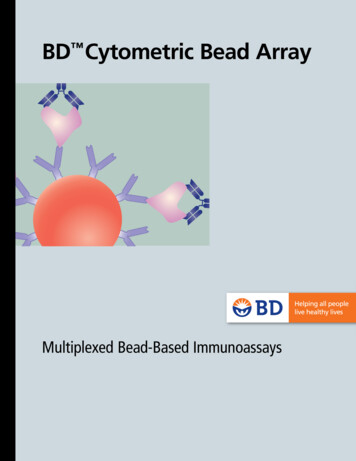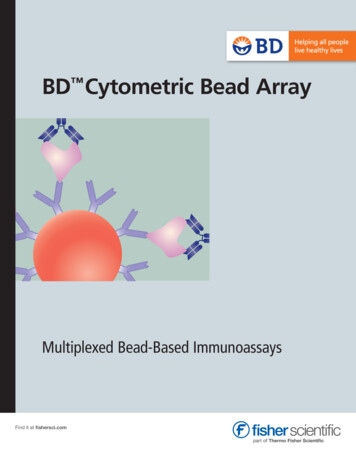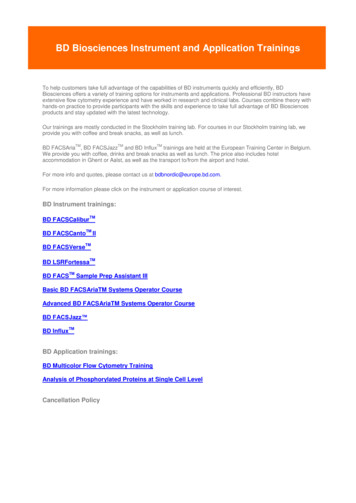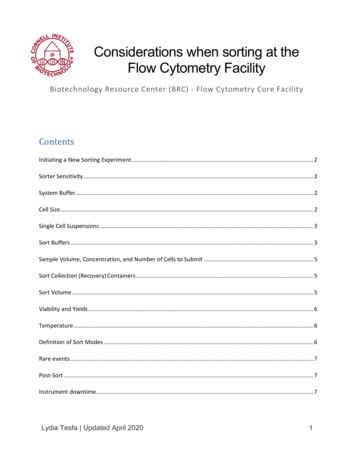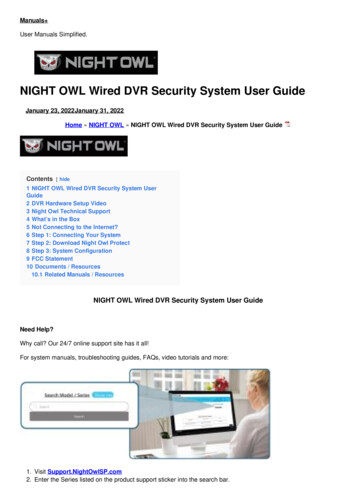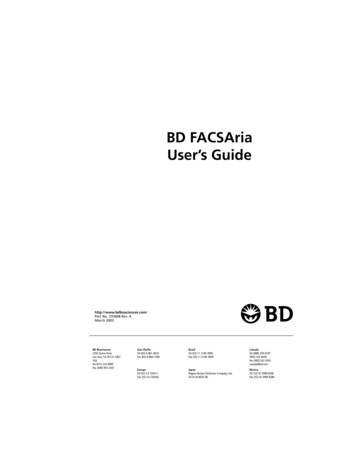
Transcription
BD FACSAriaUser’s Guidehttp://www.bdbiosciences.com/Part No. 333608 Rev. AMarch 2003BD Biosciences2350 Qume DriveSan Jose, CA 95131-1807USATel (877) 232-8995Fax (408) 954-2347Asia PacificTel (65) 6-861-0633Fax (65) 6-860-1590BrazilTel (55) 11-5185-9995Fax (55) 11-5185-9895CanadaTel (888) 259-0187(905) 542-8028Fax (905) 542-9391canada@bd.comEuropeTel (32) 53-720211Fax (32) 53-720450JapanNippon Becton Dickinson Company, Ltd.Tel 0120-8555-90MexicoTel (52) 55 5999 8296Fax (52) 55 5999 8288
2003, Becton, Dickinson and Company. All rights reserved. No part of this publication may be reproduced,transmitted, transcribed, stored in retrieval systems, or translated into any language or computer language, in anyform or by any means: electronic, mechanical, magnetic, optical, chemical, manual, or otherwise, without priorwritten permission from BD Biosciences.The information in this guide is subject to change without notice. BD Biosciences reserves the right to change itsproducts and services at any time to incorporate the latest technological developments. Although this guide has beenprepared with every precaution to ensure accuracy, BD Biosciences assumes no liability for any errors or omissions,nor for any damages resulting from the application or use of this information. BD Biosciences welcomes customerinput on corrections and suggestions for improvement.BD, the BD logo, BD CaliBRITE, BD CellQuest, BD FACS, BD FACSAria, BD FACSCalibur, BD FACSConvert,BD FACSRinse, BD FACStation, BD FACSVantage, and BD Falcon, are trademarks of Becton, Dickinson andCompany.Texas Red is a trademark of Molecular Probes, Inc. Clorox is a registered trademark of The Clorox Company. Innovais a registered trademarks of COHERENT, INC. FlowJo is a trademark of Tree Star, Inc. Java is a trademark of SunMicrosystems, Inc in the US and other countries. Microsoft and Windows are registered trademarks of MicrosoftCorporation. Q-tips is a registered trademark of Chesebrough-Pond’s Inc. Teflon is a registered trademark of E.I. duPont de Nemours and Company. Windex is a registered trademark of the Drackett Products Company.All other company and product names might be trademarks of the respective companies with which they areassociated.Guide written by Kim Gautho; edited by Joan Miller; produced by Pushpa MacFarlane.Regulatory InformationFor Research Use Only. Not for use in diagnostic procedures.WARNING: Changes or modifications to this unit not expressly approved by the party responsible for compliancecould void the user’s authority to operate the equipment.NOTE: This equipment has been tested and found to comply with the limits for a Class A digital device, pursuant toPart 15 of the FCC Rules. These limits are designed to provide reasonable protection against harmful interferencewhen the equipment is operated in a commercial environment. This equipment generates, uses, and can radiate radiofrequency energy and, if not installed and used in accordance with the instruction manual, may cause harmfulinterference to radio communications. Operation of this equipment in a residential area is likely to cause harmfulinterference in which case the user will be required to correct the interference at his or her own expense.Shielded cables must be used with this unit to ensure compliance with the Class A FCC limits.This Class A digital apparatus meets all requirements of the Canadian Interference-Causing Equipment Regulations.Cet appareil numérique de la classe A respecte toutes les exigences du Réglement sur the matériel brouilleur duCanada.HistoryRevisionDateChange Made3336081/03Initial release
ContentsAbout This GuideixConventions . . . . . . . . . . . . . . . . . . . . . . . . . . . . . . . . . . . . . . . . . . . . . . . . .xTechnical Assistance . . . . . . . . . . . . . . . . . . . . . . . . . . . . . . . . . . . . . . . . . . .xiSafety and LimitationsxiiiLaser Safety . . . . . . . . . . . . . . . . . . . . . . . . . . . . . . . . . . . . . . . . . . . . . . . . .xiiiLaser Classification . . . . . . . . . . . . . . . . . . . . . . . . . . . . . . . . . . . . . . . .xivPrecautions for Safe Operation . . . . . . . . . . . . . . . . . . . . . . . . . . . . . . . .xivElectrical Safety . . . . . . . . . . . . . . . . . . . . . . . . . . . . . . . . . . . . . . . . . . . . . .xvBiological Safety . . . . . . . . . . . . . . . . . . . . . . . . . . . . . . . . . . . . . . . . . . . . . .xviGeneral Safety . . . . . . . . . . . . . . . . . . . . . . . . . . . . . . . . . . . . . . . . . . . . . . . .xviiPrecaution Labels . . . . . . . . . . . . . . . . . . . . . . . . . . . . . . . . . . . . . . . . . . . . .xviiLimitations . . . . . . . . . . . . . . . . . . . . . . . . . . . . . . . . . . . . . . . . . . . . . . . . . .xixChapter 1: BD FACSAria Instrument Components21Fluidics Cart . . . . . . . . . . . . . . . . . . . . . . . . . . . . . . . . . . . . . . . . . . . . . . . . .22Containers and Connectors . . . . . . . . . . . . . . . . . . . . . . . . . . . . . . . . . .23Power and Operation . . . . . . . . . . . . . . . . . . . . . . . . . . . . . . . . . . . . . . .25Flow Cytometer . . . . . . . . . . . . . . . . . . . . . . . . . . . . . . . . . . . . . . . . . . . . . .26Fluidics Components . . . . . . . . . . . . . . . . . . . . . . . . . . . . . . . . . . . . . . .27Optics System . . . . . . . . . . . . . . . . . . . . . . . . . . . . . . . . . . . . . . . . . . . . .36Instrument Electronics . . . . . . . . . . . . . . . . . . . . . . . . . . . . . . . . . . . . . .41BD FACSAria Workstation . . . . . . . . . . . . . . . . . . . . . . . . . . . . . . . . . . . . . .44iii
Chapter 2: Theory of OperationFluid Movement . . . . . . . . . . . . . . . . . . . . . . . . . . . . . . . . . . . . . . . . . . . . . .46Sheath Flow . . . . . . . . . . . . . . . . . . . . . . . . . . . . . . . . . . . . . . . . . . . . . .46Sample Flow . . . . . . . . . . . . . . . . . . . . . . . . . . . . . . . . . . . . . . . . . . . . . .47Signal Generation . . . . . . . . . . . . . . . . . . . . . . . . . . . . . . . . . . . . . . . . . . . . .49Light Scatter . . . . . . . . . . . . . . . . . . . . . . . . . . . . . . . . . . . . . . . . . . . . . .49Fluorescent Signal . . . . . . . . . . . . . . . . . . . . . . . . . . . . . . . . . . . . . . . . . .50Signal Detection . . . . . . . . . . . . . . . . . . . . . . . . . . . . . . . . . . . . . . . . . . . . . .51Detector Arrays . . . . . . . . . . . . . . . . . . . . . . . . . . . . . . . . . . . . . . . . . . .51Filters . . . . . . . . . . . . . . . . . . . . . . . . . . . . . . . . . . . . . . . . . . . . . . . . . . .52Detectors . . . . . . . . . . . . . . . . . . . . . . . . . . . . . . . . . . . . . . . . . . . . . . . .56Electronic Processing . . . . . . . . . . . . . . . . . . . . . . . . . . . . . . . . . . . . . . . . . . .57Pulse Parameters . . . . . . . . . . . . . . . . . . . . . . . . . . . . . . . . . . . . . . . . . . .58Laser Delay . . . . . . . . . . . . . . . . . . . . . . . . . . . . . . . . . . . . . . . . . . . . . . .59Sorting . . . . . . . . . . . . . . . . . . . . . . . . . . . . . . . . . . . . . . . . . . . . . . . . . . . . .60Drop Formation . . . . . . . . . . . . . . . . . . . . . . . . . . . . . . . . . . . . . . . . . . .61Side-Stream Formation . . . . . . . . . . . . . . . . . . . . . . . . . . . . . . . . . . . . . .65Particle Charging . . . . . . . . . . . . . . . . . . . . . . . . . . . . . . . . . . . . . . . . . .68Conflict Resolution During Sorting . . . . . . . . . . . . . . . . . . . . . . . . . . . . .69Chapter 3: Using BD FACSDiVa Softwareiv4577Workspace Components . . . . . . . . . . . . . . . . . . . . . . . . . . . . . . . . . . . . . . . .78Instrument Controls . . . . . . . . . . . . . . . . . . . . . . . . . . . . . . . . . . . . . . . . . . .79Fluidics Controls . . . . . . . . . . . . . . . . . . . . . . . . . . . . . . . . . . . . . . . . . . .80Fluidics Level Indicators . . . . . . . . . . . . . . . . . . . . . . . . . . . . . . . . . . . . .83Instrument Configuration . . . . . . . . . . . . . . . . . . . . . . . . . . . . . . . . . . . .84Instrument Status Report . . . . . . . . . . . . . . . . . . . . . . . . . . . . . . . . . . . .85Acquisition Controls . . . . . . . . . . . . . . . . . . . . . . . . . . . . . . . . . . . . . . . .86BD FACSAria User’s Guide
Sorting Controls . . . . . . . . . . . . . . . . . . . . . . . . . . . . . . . . . . . . . . . . . . . . . .87Sort Menu . . . . . . . . . . . . . . . . . . . . . . . . . . . . . . . . . . . . . . . . . . . . . . .88Sort Setup . . . . . . . . . . . . . . . . . . . . . . . . . . . . . . . . . . . . . . . . . . . . . . . .89Sort Layout . . . . . . . . . . . . . . . . . . . . . . . . . . . . . . . . . . . . . . . . . . . . . .90Sort Report . . . . . . . . . . . . . . . . . . . . . . . . . . . . . . . . . . . . . . . . . . . . . .97Chapter 4: Running Samples99Starting Up the Instrument . . . . . . . . . . . . . . . . . . . . . . . . . . . . . . . . . . . . . .100Setting Up the Fluidics Cart . . . . . . . . . . . . . . . . . . . . . . . . . . . . . . . . . .102Instrument Quality Control . . . . . . . . . . . . . . . . . . . . . . . . . . . . . . . . . . . . .105Setting Up the Experiment . . . . . . . . . . . . . . . . . . . . . . . . . . . . . . . . . . .105Verifying Area Scaling and Laser Delay . . . . . . . . . . . . . . . . . . . . . . . . .112Reusing the Experiment . . . . . . . . . . . . . . . . . . . . . . . . . . . . . . . . . . . . .120Sample Optimization Using Instrument Setup . . . . . . . . . . . . . . . . . . . . . . . .121Creating the Experiment . . . . . . . . . . . . . . . . . . . . . . . . . . . . . . . . . . . .122Adjusting the Voltages and Threshold . . . . . . . . . . . . . . . . . . . . . . . . . .124Calculating Compensation . . . . . . . . . . . . . . . . . . . . . . . . . . . . . . . . . . .127Recording and Analyzing Data . . . . . . . . . . . . . . . . . . . . . . . . . . . . . . . . . . .129Setting Up the Acquisition Template . . . . . . . . . . . . . . . . . . . . . . . . . . .129Recording Data . . . . . . . . . . . . . . . . . . . . . . . . . . . . . . . . . . . . . . . . . . .131Analyzing Data . . . . . . . . . . . . . . . . . . . . . . . . . . . . . . . . . . . . . . . . . . .132Reusing the Analysis . . . . . . . . . . . . . . . . . . . . . . . . . . . . . . . . . . . . . . .135Saving the Analysis . . . . . . . . . . . . . . . . . . . . . . . . . . . . . . . . . . . . . . . . .135Chapter 5: Sorting137Setting Up for Sorting . . . . . . . . . . . . . . . . . . . . . . . . . . . . . . . . . . . . . . . . . .138Changing the Nozzle . . . . . . . . . . . . . . . . . . . . . . . . . . . . . . . . . . . . . . .140Setting Up the Breakoff . . . . . . . . . . . . . . . . . . . . . . . . . . . . . . . . . . . . .142Setting Up for Bulk Sorting . . . . . . . . . . . . . . . . . . . . . . . . . . . . . . . . . .143Calculating the Drop Delay . . . . . . . . . . . . . . . . . . . . . . . . . . . . . . . . . . . . .145Setting Up the Experiment . . . . . . . . . . . . . . . . . . . . . . . . . . . . . . . . . . .145Sorting Beads to Determine the Drop Delay . . . . . . . . . . . . . . . . . . . . . .146Contentsv
Sorting . . . . . . . . . . . . . . . . . . . . . . . . . . . . . . . . . . . . . . . . . . . . . . . . . . . . .149Setting Up the Experiment . . . . . . . . . . . . . . . . . . . . . . . . . . . . . . . . . . .149Starting and Monitoring the Sort . . . . . . . . . . . . . . . . . . . . . . . . . . . . . .151Setting Up for Sorting Into a Plate or Slide . . . . . . . . . . . . . . . . . . . . . . . . . .153Installing the Sorting Hardware . . . . . . . . . . . . . . . . . . . . . . . . . . . . . . .153Setting Up the Stream . . . . . . . . . . . . . . . . . . . . . . . . . . . . . . . . . . . . . . .155Creating a Custom Device . . . . . . . . . . . . . . . . . . . . . . . . . . . . . . . . . . .158Chapter 6: DNA AnalysisCriteria for DNA Experiments . . . . . . . . . . . . . . . . . . . . . . . . . . . . . . . . . . .162CEN Optimization . . . . . . . . . . . . . . . . . . . . . . . . . . . . . . . . . . . . . . . . . . . .163Setting Up the Experiment . . . . . . . . . . . . . . . . . . . . . . . . . . . . . . . . . . .164Running CEN . . . . . . . . . . . . . . . . . . . . . . . . . . . . . . . . . . . . . . . . . . . . .166CTN Resolution . . . . . . . . . . . . . . . . . . . . . . . . . . . . . . . . . . . . . . . . . . . . . .168Running CTN . . . . . . . . . . . . . . . . . . . . . . . . . . . . . . . . . . . . . . . . . . . . .168Running Test Samples . . . . . . . . . . . . . . . . . . . . . . . . . . . . . . . . . . . . . . . . . .170Chapter 7: Shutdown and Maintenancevi161171Daily Shutdown . . . . . . . . . . . . . . . . . . . . . . . . . . . . . . . . . . . . . . . . . . . . . .172Fluidics Shutdown . . . . . . . . . . . . . . . . . . . . . . . . . . . . . . . . . . . . . . . . .172External Cleaning . . . . . . . . . . . . . . . . . . . . . . . . . . . . . . . . . . . . . . . . . .174Scheduled Maintenance . . . . . . . . . . . . . . . . . . . . . . . . . . . . . . . . . . . . . . . . .177Internal Cleaning . . . . . . . . . . . . . . . . . . . . . . . . . . . . . . . . . . . . . . . . . .178Purging Filters . . . . . . . . . . . . . . . . . . . . . . . . . . . . . . . . . . . . . . . . . . . . .191Changing Fluid Filters . . . . . . . . . . . . . . . . . . . . . . . . . . . . . . . . . . . . . . .192Changing the Sample Lines . . . . . . . . . . . . . . . . . . . . . . . . . . . . . . . . . . .192Changing Air Filters . . . . . . . . . . . . . . . . . . . . . . . . . . . . . . . . . . . . . . . .196Unscheduled Maintenance . . . . . . . . . . . . . . . . . . . . . . . . . . . . . . . . . . . . . . .196Cleaning a Nozzle . . . . . . . . . . . . . . . . . . . . . . . . . . . . . . . . . . . . . . . . . .197Cleaning the Camera Optics . . . . . . . . . . . . . . . . . . . . . . . . . . . . . . . . . .199Cleaning Optical Filters . . . . . . . . . . . . . . . . . . . . . . . . . . . . . . . . . . . . .200BD FACSAria User’s Guide
Chapter 8: Troubleshooting201Troubleshooting the Stream. . . . . . . . . . . . . . . . . . . . . . . . . . . . . . . . . . . . . .202Fluidics Troubleshooting . . . . . . . . . . . . . . . . . . . . . . . . . . . . . . . . . . . . . . . .206Electronics Troubleshooting . . . . . . . . . . . . . . . . . . . . . . . . . . . . . . . . . . . . .207Acquisition Troubleshooting . . . . . . . . . . . . . . . . . . . . . . . . . . . . . . . . . . . . .208Sorting Troubleshooting . . . . . . . . . . . . . . . . . . . . . . . . . . . . . . . . . . . . . . . .214Appendix A: Supplies and Options217Instrument Supplies . . . . . . . . . . . . . . . . . . . . . . . . . . . . . . . . . . . . . . . . . . .218Optical Components . . . . . . . . . . . . . . . . . . . . . . . . . . . . . . . . . . . . . . .218Accessory Kit . . . . . . . . . . . . . . . . . . . . . . . . . . . . . . . . . . . . . . . . . . . . .219Other Replacement Parts . . . . . . . . . . . . . . . . . . . . . . . . . . . . . . . . . . . .221Consumables . . . . . . . . . . . . . . . . . . . . . . . . . . . . . . . . . . . . . . . . . . . . . . . .222Instrument Setup Particles . . . . . . . . . . . . . . . . . . . . . . . . . . . . . . . . . . .222Reagents . . . . . . . . . . . . . . . . . . . . . . . . . . . . . . . . . . . . . . . . . . . . . . . . .223Labware . . . . . . . . . . . . . . . . . . . . . . . . . . . . . . . . . . . . . . . . . . . . . . . . .224Instrument Options . . . . . . . . . . . . . . . . . . . . . . . . . . . . . . . . . . . . . . . . . . . .225Application Options . . . . . . . . . . . . . . . . . . . . . . . . . . . . . . . . . . . . . . . . . . .226Two-Laser System . . . . . . . . . . . . . . . . . . . . . . . . . . . . . . . . . . . . . . . . .226Three-Laser System . . . . . . . . . . . . . . . . . . . . . . . . . . . . . . . . . . . . . . . .227Changing Filters . . . . . . . . . . . . . . . . . . . . . . . . . . . . . . . . . . . . . . . . . . .228Defining a New Configuration . . . . . . . . . . . . . . . . . . . . . . . . . . . . . . . .230Index233Contentsvii
viiiBD FACSAria User’s Guide
About This GuideThis user’s guide contains the instructions necessary to operate and maintainyour BD FACSAria flow cytometer. Because many instrument functions arecontrolled by BD FACSDiVa software, this guide also contains basic softwareinformation needed for instrument setup. For more detailed instructions on howto use the software, refer to the BD FACSDiVa Software User’s Guide.The BD FACSAria User’s Guide assumes you have a working knowledge of basicMicrosoft Windows operation. If you are not familiar with the Windowsoperating system, refer to the documentation provided with your computer.New users of the BD FACSAria flow cytometer should read: Chapter 1 to become familiar with your instrument components Chapter 2 to understand how the instrument works and to learn about thesoftware components used to control different subsystems Chapter 3 to see where software components are locatedInstructions for routine acquisition, analysis, and sorting can be found inChapters 4 and 5. For information about running DNA samples, see Chapter 6.Once you become familiar with routine operation and need only a quickreminder of the main steps, use the quick reference guide located in the frontpocket of this user’s guide.ix
ConventionsThe following tables list conventions used throughout this guide. Table 1 lists thesymbols that are used to alert you to a potential hazard. The word accompanyingthe hazard symbol indicates the level of severity, as shown in Table 2. Text andkeyboard conventions are shown in Table 3.Table 1 Hazard iconsSymbol BHazardDangerous voltageLaser radiationSymbol HazardHighly flammableGeneralBiological riskTable 2 Severity indicatorsaIndicatorLevel of SeverityWARNINGThe hazard or unsafe practice could result in severe injury or death.CAUTIONThe hazard or unsafe practice could result in minor injury.NOTICEThe hazard or unsafe practice could result in a possibly dangeroussituation; material could be damaged or data could be lost.a. In compliance with the ANSI Z535.4 standard: Product Safety Signs and LabelsxBD FACSAria User’s Guide
Table 3 Text and keyboard conventionsConvention TipUseHighlights features or hints that can save time and preventdifficultiesItalicsItalics are used to highlight book titles and new or unfamiliarterms on their first appearance in the text. The arrow indicates a menu choice. For example, “chooseFile Print” means to choose Print from the File menu.Ctrl-XWhen used with key names, a dash means to press two keyssimultaneously. For example, Ctrl-P means to hold down theControl key while pressing the letter p.Technical AssistanceFor technical questions or assistance in solving a problem: Read the section of the user’s guide specific to the operation you areperforming. See Chapter 8, Troubleshooting.If additional assistance is required, contact your local BD Biosciences technicalsupport representative or supplier.When contacting BD Biosciences, have the following information available: product name, part number, and serial number any error messages details of recent system performanceFor instrument support from within the US, call (877) 232-8995, prompt #2-2.For support from within Canada, call (888) 259-0187.About This Guidexi
Customers outside the US and Canada, contact your local BD representative ordistributor.xiiBD FACSAria User’s Guide
Safety and LimitationsThe BD FACSAria flow cytometer is equipped with safety features for yourprotection. Operate the instrument only as directed in the user’s guide. Keep thissafety information available for future reference and for new users.Laser SafetyLasers or laser systems emit intense, coherent electromagnetic radiation that hasthe potential of causing irreparable damage to human skin and eyes. The mainhazard of laser radiation is direct or indirect exposure of the eye to thermalradiation from the visible and near-infrared spectral regions (325–1,400 nm).Direct eye contact can cause corneal burns, retinal burns, or both, and possibleblindness.There are other potentially serious hazards in other spectral regions. Excessiveultraviolet exposure produces an intolerance to light (photophobia) accompaniedby redness, a tearing discharge from the mucous membrane lining the innersurface of the eyelid (conjunctiva), shedding of the corneal cell layer surface(exfoliation), and stromal haze. These symptoms are associated withphotokeratitis, otherwise known as snow blindness or welder’s flash, whichresults from radiant energy–induced damage to the outer epidermal cell layer ofthe cornea. These effects can be the result of laser exposure lasting only a fractionof a second.xiii
Laser ClassificationLaser hazard levels depend on laser energy content and the wavelengths used. Anumbered system is used to categorize lasers according to different hazard levels.The higher the classification number, the greater the potential hazard. TheBD FACSAria flow cytometer is a Class I laser product per 21 CFR Subchapter Jand EN 60825-1:1994 A2:2001. The lasers are fully contained within theinstrument structure and call for no special work area safety requirements exceptduring service procedures. These procedures are to be carried out only byBD Biosciences service personnel.Precautions for Safe Operation WARNINGModification or removal of the optics covers or laser shielding couldresult in exposure to hazardous laser radiation. To prevent irreparable damage tohuman skin and eyes, do not remove the optics covers or laser shielding, adjustcontrols, or attempt to service the instrument any place where laser warning labelsare attached (see Precaution Labels on page xvii). CAUTIONControls, adjustments, or performance of procedures other than thosespecified in the BD FACSAria User’s Guide can result in exposure to hazardousvisible or ultraviolet laser radiation, or both. CAUTIONKeep all instrument doors closed during instrument operation. Whenoperated under these conditions, the instrument poses no danger of exposure tohazardous laser radiation.xivBD FACSAria User’s Guide
Electrical Safety WARNINGLethal electrical hazards are present in some lasers, particularly inlaser power supplies. Many portions of the electrical system, including the printedcircuit boards, are at a dangerous voltage level. To prevent shock injury, followthese guidelines. Connect the equipment only to an approved power source. Do not useextension cords. Have an electrician immediately replace any damagedcords, plugs, or cables. Do not remove the grounding prong from the power plug. Have a qualifiedelectrician replace any ungrounded receptacles with properly groundedreceptacles in accordance with the local electrical code. Do not perform instrument maintenance or service procedures except asspecifically stated in the user’s guide. WARNINGA 12,000-volt potential exists between the deflection plates when theyare on. Contact with the charged plates results in serious electrical shock. Do nottouch the deflection plates when the voltage warning light is illuminated, or whenthe software indicates that the plate voltage is on. The plates remain energizedeven when the sort block door is opened. CAUTIONThe nozzle and the stream-charging wire conduct electrical chargeduring sorting. To prevent shock, do not touch the nozzle or the stream-chargingwire when the voltage warning light is illuminated or any time during sorting.Safety and Limitationsxv
Biological SafetyB WARNINGAll biological specimens and materials coming into contact with themcan transmit potentially fatal disease. To prevent exposure to biohazardousagents, follow these guidelines. Handle all biological specimens and materials as if capable of transmittinginfection. Dispose of waste using proper precautions and in accordancewith local regulations. Never pipette by mouth. Wear suitable protectiveclothing, eyewear, and gloves. Expose waste container contents to bleach (10% of total volume) beforedisposal. Dispose of waste in accordance with local regulations. Use properprecaution and wear suitable protective clothing, eyewear, and gloves. Prevent waste overflow by emptying the waste container daily or wheneverthe waste indicator shows the waste is getting full.B WARNINGCell sorters that use droplet generation methods, like theBD FACSAria, can produce aerosols around the sample stream. When acquiringbiohazardous samples, follow universal precautions at all times. Keep the sortblock door closed during sorting. If you need to access the sort block, turn off thestream before opening the door.For information on laboratory safety, refer to the following guidelines. NCCLSdocuments can be ordered online at www.nccls.org.xvi Schmid I, Nicholson JKA, Giorgi JV, et al. Biosafety guidelines for sortingof unfixed cells. Cytometry. 1997;28:99-117. Protection of Laboratory Workers from Instrument Biohazards andInfectious Disease Transmitted by Blood, Body Fluids, and Tissue;Approved Guideline. Wayne, PA: National Committee for ClinicalLaboratory Standards, 1997. NCCLS document M29-A. Procedures for the Handling and Processing of Blood Specimens; ApprovedGuideline. Wayne, PA: National Committee for Clinical LaboratoryStandards; 1990. NCCLS document H18-A.BD FACSAria User’s Guide
General Safety CAUTIONMovement of mechanical parts within the instrument can pinch orinjure your hands or fingers. To prevent injury by moving parts, follow theseprecautions. Keep your hands and clothing away from the sample injection chamberwhen a tube is loading or unloading. Do not place objects underneath thesample injection chamber. Keep your hands away from the sort aspirator drawer during sorting. Thedrawer can close at any time without warning if a clog is detected duringsorting. When sorting into a plate, keep the sort collection chamber door closedduring sorting. Do not place objects inside the sort collection chamber, anddo not attempt to access the plate until sorting is complete. The microtitertray stage can move suddenly during the sorting process. Sorting continueseven when the sort collection chamber door is opened.Precaution LabelsThe following precaution labels appear on the BD FACSAria flow cytometer orfluidics cart to indicate a potential hazard. Do not remove these labels. Useappropriate precaution to avoid injury by the indicated hazard. See the previoussections in this booklet for more information.LabelBWasteLocation(s)Potential HazardWaste tank, waste tankconnectors on fluidics cartRisk of exposure tobiologically transmissiblediseaseSafety and Limitationsxvii
Label Ethanol Location(s)Potential HazardWaste tank capRisk of exposure tobiologically transmissiblediseaseEthanol tank, ethanol tankconnectors on fluidics cartHighly flammable materialEthanol tank capHighly flammable materialDeflection plates indicatorlightDangerous voltageSort block door wheredeflection plates can beaccessed (inside andoutside)Dangerous voltageEthanol DeflectionPlatesxviii BD FACSAria User’s Guide
LabelLocation(s)Potential Hazard On or near all removablecovers and any placewhere the laser beam canemerge from theinstrumentRisk of exposure tohazardous laser radiationBehind sample injectionchamberRisk of crushing orpinching by moving partsFloor of sort collectionchamberRisk of crushing orpinching by moving partsPower input on fluidicscartRisk of instrument damageif wrong voltage VISIBLELASER RADIATIONWHENVISIBLELASERREMOVED.AVOIDEYE REMOVED.OR SKIN EXPOSURETORADIATIONWHENAVOIDOR SCATTEREDRADIATION.EYEDIRECTOR SKINEXPOSURETO DIRECTOR SCATTERED RADIATION. 95-10361-0095-10361-00!CAUTION:MOVING PARTS!Peel Here!WARNING: Before applyingpower, configure the powerinput module to the supplyvoltage. Consult the user'sguide for instructions.a. NOTE: Voltage is set by your service engineer during installation.LimitationsThis instrument is for Research Use Only. Not for use in diagnostic ortherapeutic procedures.Safety and Limitationsxix
xxBD FACSAria User’s Guide
1BD FACSAriaInstrument ComponentsThe BD FACSAria flow cytometer is the first fixed-alignment benchtop highspeed cell sorter. The instrument can be operated at varied pressures and canacquire up to 70,000 events per second. With its fixed-optics design and digitalelectronics, the BD FACSAria flow cytometer enables multicolor analysis of up to13 fluorescent markers and two scatter parameters at a time.The BD FACSAria system consists of three major components: a fluidics cart, abenchtop flow cytometer, and the BD FACSAria workstation (see Figure 1-1 onpage 22). Nearly all instrument functions are operated from withinBD FACSDiVa software.For a description of the BD FACSAria system components, see the followingsections. For technical information about how the instrument works, seeChapter 2. Fluidics Cart on page 22 Flow Cytometer on page 26 BD FACSAria Workstation on page 4421
flow cytometerfluidics cartworkstationFigure 1-1 BD FACSAria instrument componentsFluidics CartA separate fluidics cart supplies sheath and cleaning fluids and collects wastefrom the instrument (Figure 1-2). The self-contained fluidics cart supplies therequired air pressure and vacuum, which eliminates the need for an externalsource (although the cart can be hooked up to an in-house air source, if one isavailable). The air pumps provide pressure from 2 to 75 psi to accommodate avariety of cell sorting applications. Air pressure is adjusted within BD FACSDiVasoftware.10-L container5-L containerpressuregaugedooraccess knobFigure 1-2 Fluidics cart22BD FACSAria User’s Guidefilter
Containers and ConnectorsThe fluidics cart holds four 10-L containers (two sheath and two waste), andthree 5-L auxiliary cleaning fluid containers (Figure 1-3). All containers, caps,level sensors, and
BD FACSAria flow cytometer is a Class I laser product per 21 CFR Subchapter J and EN 60825-1:1994 A2:2001. The lasers are fully contained within the instrument structure and call for no special work area safety requirements except during service procedures. These procedures are to be carried out only by BD Biosciences service personnel.

